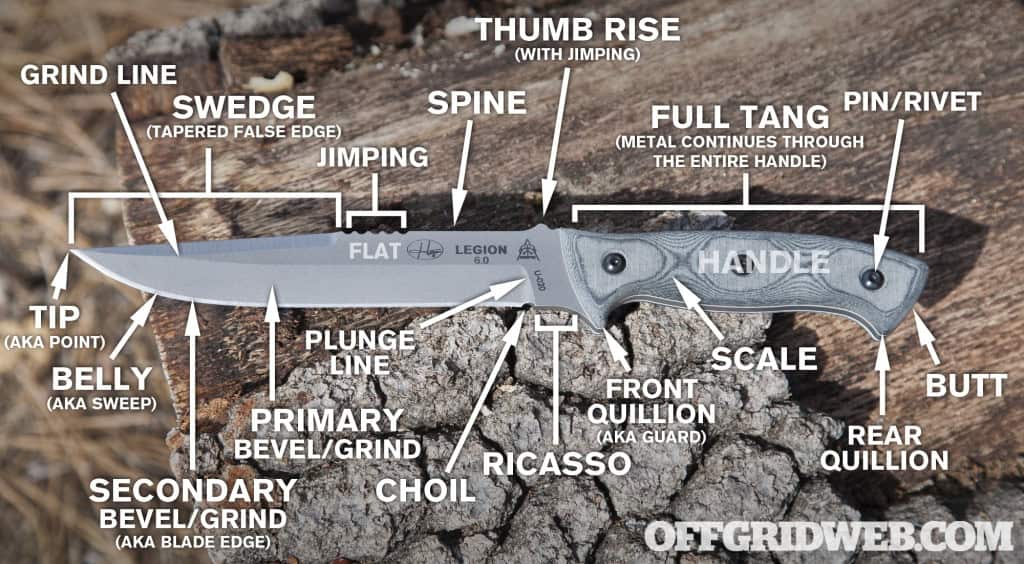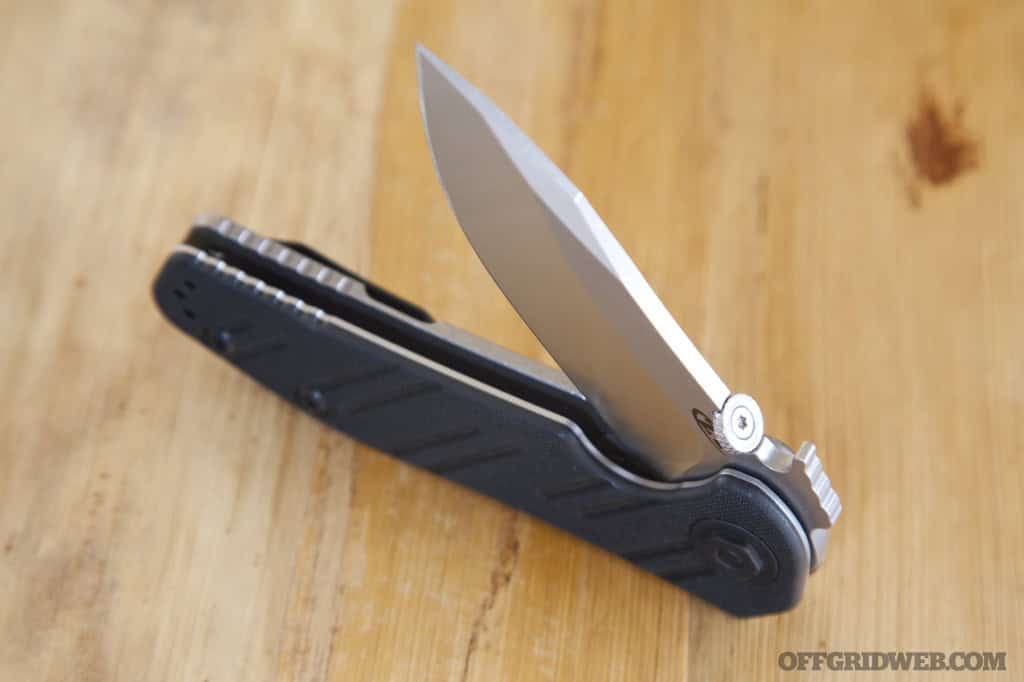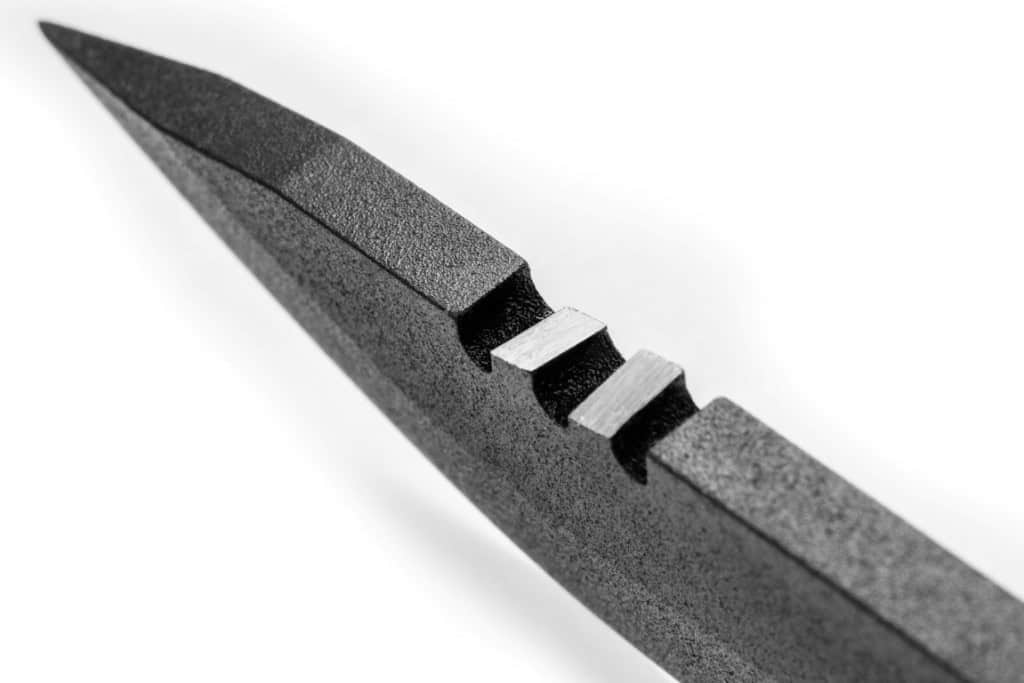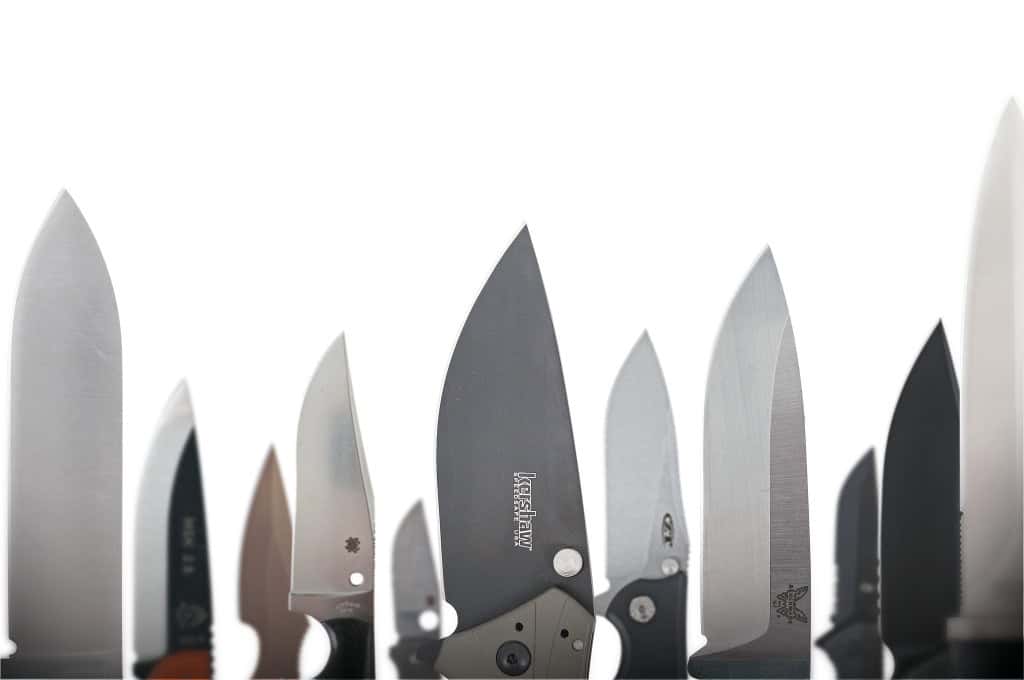
If you're an avid knife collector or enthusiast, it's essential to familiarize yourself with the terminology associated with blade designs. While you might get away with using casual terms like “the stabby part” or “the sharpened bit,” using the correct knife anatomy terms not only eliminates confusion but also showcases your knowledge and expertise on the subject.
At first glance, knife terms can seem overwhelming and difficult to remember. To help you out, we've created an infographic that illustrates the 20 different parts of a fixed blade knife. For this illustration, we've used the TOPS Knives Hazen Legion 6.0, a popular choice among knife enthusiasts. You can find a complete review of this fixed blade knife on our website.
Exploring the Different Knife Anatomy Terms
While the infographic provides a visual representation of the various knife parts, here's a more detailed explanation of each term:
1. Grind Line
The grind line refers to the meeting point of a grind with a flat surface or opposing grind. In the illustration, it's the line where the swedge meets the flat and the primary bevel.
2. Swedge
The swedge, also spelled swage, is a tapered or beveled false edge along the spine of the knife. It's usually not fully sharpened and reduces the point thickness for improved piercing ability.
3. Jimping
Jimping refers to repeating ridges or cuts on the knife. These can be decorative, such as those on the spine, or used for additional grip, such as those on the thumb rise.
4. Spine
The spine is the top edge of the knife, opposite the blade edge. It runs all the way from the tip to the butt.

5. Thumb Rise
Also known as a thumb ramp, the thumb rise is a slight incline in the spine. It provides a place for the user's thumb while cutting.
6. Tang
The tang refers to the continuation of a fixed-blade knife's metal into the handle. In the case of the TOPS knife mentioned earlier, it's a full tang, meaning the metal extends through the entire handle to the butt.
7. Pin/Rivet
A pin or rivet is the hardware that holds the scales onto the handle.
8. Flat
The flat is the unground face of the knife. It's often where you'll find etching or emblems applied.
9. Handle
The handle is the part of the knife that you hold. It's as simple as that.
10. Tip
The tip, also referred to as the point, is the sharp end of the knife. Technically, the tip is the very end, while the point includes the first few inches of the blade.
11. Belly
The belly, also known as the sweep, refers to the upwards-curved section of the blade edge. Some knives, like the Wharncliffe design, lack a curved belly.

12. Primary Bevel or Primary Grind
The primary bevel or primary grind is the first grind applied to the knife edge. Many knives only have a single bevel that forms the blade edge.
13. Secondary Bevel or Secondary Grind
The secondary bevel or secondary grind is the second grind applied to the knife. It alters the primary bevel to a new angle. Knives with two bevels, like the TOPS knife mentioned earlier, are considered compound or double beveled.
14. Plunge Line
The plunge line is the abrupt ending of the bevel, where it meets the flat near the handle.
15. Choil
A choil is a curved indentation or notch at the end of the blade edge. It can sometimes be large enough to fit a finger into, but in the case of the illustrated knife, it's relatively small.
16. Ricasso
The ricasso is a thick, flat, unground portion between the end of the bevel(s) and the beginning of the handle.
17. Front Quillion or Front Guard
The front quillion or front guard is the part of the knife handle that prevents your fingers from slipping onto the blade while pushing the knife forward.
18. Rear Quillion or Rear Guard
The rear quillion or rear guard is the part of the handle that prevents your fingers from slipping while drawing the knife backward.

19. Scales
Scales are pieces of handle material, such as wood, bone, or polymer, that are attached to the knife's tang using rivets, pins, or other hardware.
20. Butt
The butt is the rear end of the knife. It may contain a lanyard hole or glass breaker. Some knives may also have separate metal pommels attached here.
While our infographic provides a comprehensive overview of knife anatomy, there are a few additional terms worth mentioning:
1. Bolster
A bolster is a thick junction between the handle and the flat of the blade. It can be found at the front and rear of some knives, and its purpose is to strengthen the knife and add balance.
2. Guard
The guard is a part of the handle that prevents the user's hand from slipping. It can be a curved quillion on the handle or a separate guard plate installed between the handle and blade.
3. Fuller
A fuller, also known as cannelure or blood groove, is a groove cut into the blade. It's often found at the center of double-edged knives and swords. Contrary to popular belief, the term “blood groove” is a myth, as there is little to no evidence that it functions as such. In reality, a fuller lightens the blade by removing steel and may provide added stiffness to certain blade designs.
4. Serration
Serration refers to repeated jagged cuts into the blade edge. It provides the ability to saw and tear through tough materials.

5. Pivot
A pivot is a component found only on folding knives. It's where the blade attaches to the handle. Some knives feature caged ball bearing pivots for smoother opening.
6. Liner
A liner is a flat metal plate inside the handle of a folding knife. It provides structure for the pivot and handle scales and may also serve as part of the locking mechanism, known as a “liner lock”.
7. Line Cutter or Seatbelt Cutter
A line cutter or seatbelt cutter is a sharpened notch in the blade designed to slice through cordage or seatbelts. Some knives use a slotted opening in the handle or sheath instead of a notch in the blade edge.
8. Glass Breaker
A glass breaker is a sharpened point on the butt of the knife designed to crack and shatter glass. Some knives may feature a dedicated carbide point, while others may use a pointed extension of the tang for this purpose.
9. Finger Groove
A finger groove refers to distinct grooves or notches on the handle. These are designed to fit between the user's fingers and provide extra grip.
10. Clip
A clip is a portion of the spine near the tip that is angled down or “clipped off” for improved piercing ability. Knives with this feature are often called “clip point” knives.
By understanding these knife anatomy terms, you'll be well-equipped to navigate the world of knives and make informed decisions based on your needs and preferences. Whether you're a seasoned collector or just starting your journey, expanding your knowledge of knife anatomy is a valuable asset.

For more informative articles and updates, subscribe to Recoil Offgrid's free newsletter. Stay informed, stay prepared!
RECOIL Teaches Us Cigar Etiquette & Anatomy
Do You Know Your Blade Grinds and Profiles?
A Poor Man's Guide to Knife Making
Review: Cold Steel Survival Edge Knife
Bushcraft Blades Buyer's Guide
The post Knife Anatomy 101: Infographic & Terms appeared first on RECOIL OFFGRID.
 —————————————————————————————————————————————————————————————–
—————————————————————————————————————————————————————————————–
By: Patrick McCarthy
Title: Understanding Knife Anatomy: A Comprehensive Guide
Sourced From: www.offgridweb.com/gear/knife-anatomy-101-infographic-terms/
Published Date: Sun, 24 Dec 2023 12:00:28 +0000


